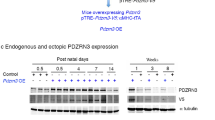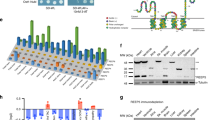Abstract
Although cytoskeletal mutations are known causes of genetically based forms of dilated cardiomyopathy, the pathways that link these defects with cardiomyopathy are unclear. Here we report that the α-actinin–associated LIM protein (ALP; Alp in mice) has an essential role in the embryonic development of the right ventricular (RV) chamber during its exposure to high biomechanical workloads in utero. Disruption of the gene encoding Alp (Alp) is associated with RV chamber dilation and dysfunction, directly implicating α-actinin–associated proteins in the onset of cardiomyopathy. In vitro assays showed that Alp directly enhances the capacity of α-actinin to cross-link actin filaments, indicating that the loss of Alp function contributes to destabilization of actin anchorage sites in cardiac muscle. Alp also colocalizes at the intercalated disc with α-actinin and γ-catenin, the latter being a known disease gene for human RV dysplasia. Taken together, these studies point to a novel developmental pathway for RV dilated cardiomyopathy via instability of α-actinin complexes.
This is a preview of subscription content, access via your institution
Access options
Subscribe to this journal
Receive 12 print issues and online access
$209.00 per year
only $17.42 per issue
Buy this article
- Purchase on Springer Link
- Instant access to full article PDF
Prices may be subject to local taxes which are calculated during checkout







Similar content being viewed by others
References
Hunter, J.J. & Chien, K.R. Signaling pathways for cardiac hypertrophy and failure. New Engl. J. Med. 341, 1276–1283 (1999).
Chien, K.R. Stress pathways and heart failure. Cell 98, 555–558 (1999).
Hirota, H. et al. Loss of a gp130 cardiac muscle cell survival pathway is a critical event in the onset of heart failure during biomechanical stress. Cell 97, 189–198 (1999).
Minamisawa, S. et al. Chronic phospholamban-sarcoplasmic reticulum calcium ATPase interaction is the critical calcium cycling defect in dilated cardiomyopathy. Cell 99, 313–322 (1999).
Miyamoto, M.I., et al. Adenoviral gene transfer of SERCA2a improves left-ventricular function in arotic-banded rats in transition to heart failure. Proc. Natl. Acad. Sci. USA 97, 793–798 (2000).
Arber, S. et al. MLP-deficient mice exhibit a disruption of cardiac cytoarchitectural organization, dilated cardiomyopathy, and heart failure. Cell 88, 393–403 (1997).
Coral-Vazquez, R. et al. Disruption of the sarcoglycan-sarcospan complex in vascular smooth muscle: a novel mechanism for cardiomyopathy and muscular dystrophy. Cell 98, 465–474 (1999).
Olson, T.M., Michels, V.V., Thibodeau, S.N., Tai, Y.S. & Keating, M.T. Actin mutations in dilated cardiomyopathy, a heritable form of heart failure. Science 280, 750–752 (1998).
Towbin, J.A. & Bowles, N.E. Genetic abnormalities responsible for dilated cardiomyopathy. Curr. Cardiol. Rep. 2, 475–480 (2000).
Corrado, D. et al. Arrhythmogenic right ventricular dysplasia/cardiomyopathy: need for an international registry. Study Group on Arrhythmogenic Right Ventricular Dysplasia/Cardiomyopathy of the Working Groups on Myocardial and Pericardial Disease and Arrhythmias of the European Society of Cardiology and of the Scientific Council on Cardiomyopathies of the World Heart Federation. Circulation 101, E101–106 (2000).
Fontaine, G., Fontaliran, F. & Frank, R. Arrhythmogenic right ventricular cardiomyopathies: clinical forms and main differential diagnoses. Circulation 97, 1532–1535 (1998).
McKoy, G. et al. Identification of a deletion in plakoglobin in arrhythmogenic right ventricular cardiomyopathy with palmoplantar keratoderma and woolly hair (Naxos disease). Lancet 355, 2119–2124 (2000).
Xia, H., Winokur, S.T., Kuo, W.L., Altherr, M.R. & Bredt, D.S. Actinin–associated LIM protein: identification of a domain interaction between PDZ and spectrin-like repeat motifs. J. Cell Biol. 139, 507–515 (1997).
Nieset, J.E. et al. Characterization of the interactions of α-catenin with α-actinin and β-catenin/plakoglobin. J. Cell Sci. 110, 1013–1022 (1997).
Vallenius, T., Luukko, K. & Makela, T.P. CLP-36 PDZ-LIM protein associates with nonmuscle α-actinin-1 and α-actinin-4. J. Biol. Chem. 275, 11100–11105 (2000).
Wang, H., Harrison-Shostak, D.C., Lemasters, J.J. & Herman, B. Cloning of a rat cDNA encoding a novel LIM domain protein with high homology to rat RIL. Gene 165, 267–271 (1995).
Kiess, M. et al. Expression of ril, a novel LIM domain gene, is down-regulated in Hras-transformed cells and restored in phenotypic revertants. Oncogene 10, 61–68 (1995).
Pomiès, P., Louis, H.A. & Beckerle, M.C. CRP1, a LIM domain protein implicated in muscle differentiation, interacts with α-actinin. J. Cell Biol. 139, 157–168 (1997).
Pomiès, P., Macalma, T. & Beckerle, M.C. Purification and characterization of an α-actinin-binding PDZ-LIM protein that is up-regulated during muscle differentiation. J. Biol. Chem. 274, 29242–29250 (1999).
Rockman, H.A. et al. Segregation of atrial-specific and inducible expression of an atrial natriuretic factor transgene in an in vivo murine model of cardiac hypertrophy. Proc. Natl. Acad. Sci. USA. 88, 8277–8281 (1991).
Tanaka, N. et al. Transthoracic echocardiography in models of cardiac disease in the mouse. Circulation 94, 1109–1117 (1996).
Fontaine, G. et al. Arrhythmogenic right ventricular dysplasia. Ann. Rev. Med. 50, 17–35 (1999).
Lewis, J.E. et al. Cross-talk between adherens junctions and desmosomes depends on plakoglobin. J. Cell Biol. 136, 919–934 (1997).
Cowin, P., Kapprell, H.P., Franke, W.W., Tamkun, J. & Hynes, R.O. Plakoglobin: a protein common to different kinds of intercellular adhering junctions. Cell 46, 1063–1073 (1986).
Ruiz, P. et al. Targeted mutation of plakoglobin in mice reveals essential functions of desmosomes in the embryonic heart. J. Cell Biol. 135, 215–225 (1996).
Knudsen, K.A., Soler A.P., Johnson, K.R., Wheelock, M.J. Interaction of α-actinin with the cadherin/catenin cell-cell adhesion complex via α-catenin. J. Cell Biol. 130, 67–77 (1995).
Djinovic-Carugo, K., Young, P., Gautel, M. & Saraste, M. Structure of the α-actinin rod: molecular basis for cross-linking of actin filaments. Cell 98, 537–546 (1999).
Blanchard, A., Ohanian, V. & Critchley, D. The structure and function of α-actinin. J. Muscle Res. Cell Motil. 10, 280–289 (1989).
Meyer, R.K. & Aebi, U. Bundling of actin filaments by α-actinin depends on its molecular length. J. Cell Biol. 110, 2013–2024 (1990).
Chien, K.R. Genomic circuits and the integrative biology of complex cardiac diseases. Nature 407, 227–232 (2000).
Fontaine, G. et al. Fat in the heart. A feature unique to the human species? Observational reflections on an unsolved problem. Acta. Cardiol. 54, 189–194 (1999).
Basso, C. et al. Arrhythmogenic right ventricular cardiomyopathy. Dysplasia, dystrophy, or myocarditis? Circulation 94, 983–991 (1996).
Sutton, M.S., Gill, T., Plappert, T., Saltzman, D.H. & Doubilet, P. Assessment of right and left ventricular function in terms of force development with gestational age in the normal human fetus. Br. Heart. J. 66, 285–289 (1991).
Murata, K. et al. The influence of coronary collateral flow on the assessment of myocardial perfusion by videodensitometry. Cardiovasc. Res. 33, 359–369 (1997).
Acknowledgements
We thank S. Evans and J. Chen for helpful comments; N. Dalton and Y. Gu for technical help with echocardiography and right/left heart catheterization; and E. King for contributing to electron microscopic analysis. This work was supported by grants from the Muscular Dystrophy Association (M.C.B.), the NIH (M.C.B. and K.R.C.) and the Jean Le Ducq Foundation (K.R.C.). M.C.B. is an Investigator of the Huntsman Cancer Institute. K.R.C. is supported by an Endowed Chair from the American Heart Association (California Affiliate).
Author information
Authors and Affiliations
Corresponding author
Rights and permissions
About this article
Cite this article
Pashmforoush, M., Pomiès, P., Peterson, K. et al. Adult mice deficient in actinin–associated LIM-domain protein reveal a developmental pathway for right ventricular cardiomyopathy. Nat Med 7, 591–597 (2001). https://doi.org/10.1038/87920
Received:
Accepted:
Issue Date:
DOI: https://doi.org/10.1038/87920
This article is cited by
-
PDLIM3 supports hedgehog signaling in medulloblastoma by facilitating cilia formation
Cell Death & Differentiation (2023)
-
Integrated proteomic and transcriptomic profiling identifies aberrant gene and protein expression in the sarcomere, mitochondrial complex I, and the extracellular matrix in Warmblood horses with myofibrillar myopathy
BMC Genomics (2021)
-
Cardiac MLC2 kinase is localized to the Z-disc and interacts with α-actinin2
Scientific Reports (2019)
-
Molecular Characterization of Pediatric Restrictive Cardiomyopathy from Integrative Genomics
Scientific Reports (2017)
-
Comparative transcriptomic and proteomic analyses provide insights into the key genes involved in high-altitude adaptation in the Tibetan pig
Scientific Reports (2017)



